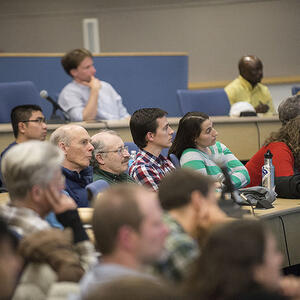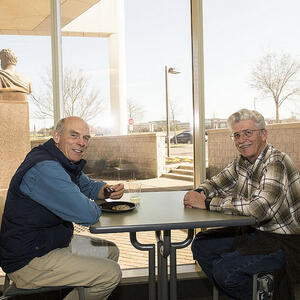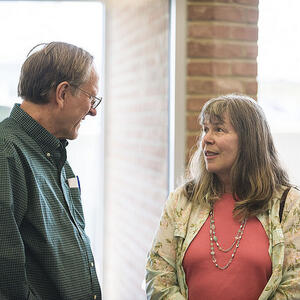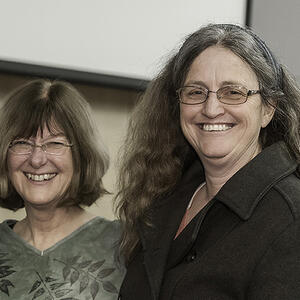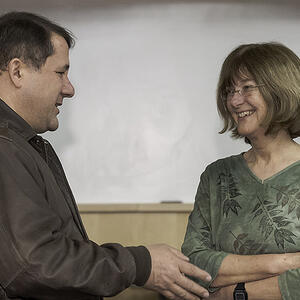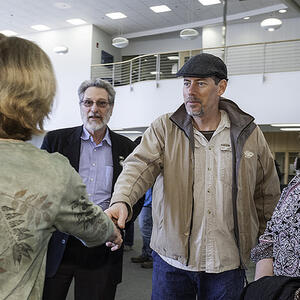The annual lecture is named in honor of Wayne Carmichael, Ph.D., professor emeritus in biological sciences and the first director of Wright State’s Environmental Sciences Ph.D. program.
On this page:
2021
“PFAS: Forever chemicals, today’s problem”
Dr. Marta Venier, Indiana University
Virtual Lecture
April 19, 2021, 1:25–2:20 p.m.
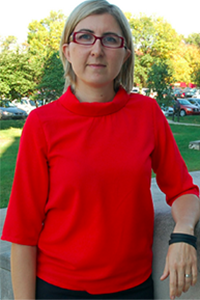
Biography: Dr. Marta Venier is an environmental chemist and Assistant Professor at the Paul O’Neill School of Public and Environmental Affairs at Indiana University in Bloomington, Indiana. In her research, she employs analytical chemistry and mass spectrometry techniques to study the fate, transport, and behavior of persistent organic pollutants in the indoor and outdoor environment, including both legacy and emerging pollutants. Since November 2019, she has been leading the Integrated Atmospheric Deposition Network (IADN), a monitoring program funded by the U.S. Environmental Protection Agency.
2019
“Discovery and Renewal on Huffman Prairie, where Aviation Took Wing”
Mr. Dave Nolin
Tuesday, March 12, 2019, 6 p.m.
Gandhi Auditorium, White Hall
Dave Nolin tells the region’s story from before the time when great continental glaciers covered much of what is now Ohio to the present. He will address the natural and human history of the site known as Huffman Prairie located on Wright-Patterson Air Force Base and the changes made to it by Native Americans, early settlers, farmers, flood control engineers, and the U.S. government. He will describe how part of the natural prairie survived, spurring its restoration into a shining example of the tallgrass prairies that once graced Midwestern landscapes. Expect some stunning visuals of the varied life of the prairie, as well as an overview of the Dayton Aviation National Historical Park that protects and interprets the Wright brothers’ flying field.
Mr. Nolin grew up in Fairborn, where he graduated in 1980 from Wright State University with a BS in Biology. He received his MS in Biology from Wright State in 1984. Mr. Nolin’s thesis research was on the use of nest boxes by American Kestrels on Dayton area nature reserves.
In 1985, he joined the Park District of Dayton-Montgomery County as the agency’s first Land Stewardship Specialist. For 30 years, he was employed by the Park District, now called Five Rivers Metro Parks, and was responsible for habitat management and land acquisition. He negotiated and closed on over 7,000 acres of new natural areas and conservation easements for the agency during that time. In 2012, Mr. Nolin
was awarded the Jack Hanna Resource Conservation Award by the Ohio Parks and Recreation Association.
Mr. Nolin retired from Five Rivers Metro Parks in 2015 and is now volunteering for several conservation entities including Greene County Park District, Centerville-Washington Park District, Beaver Creek Wetlands Association, BW Greenway Community Land Trust, Wright- Patterson Air Force Base, Five Rivers Metro Parks, and Upper River Fund of the Dayton Foundation. Mr. Nolin is married to his wife of 38 years, Catherine Queener, also a Wright State grad and long-time employee, and they have a son Jacob who is 25 and an English teacher in China.
2018
“Zoos as applied conservation powerhouses: from behind the scenes to the international spotlight”
Dr. Brandie Smith, Smithsonian National Zoo & Conservation Biology Institute
Tuesday, April 10, 2018, 6 p.m.
Gandhi Auditorium, White Hall
BIOGRAPHY Brandie Smith oversees the care and management of the ~ 4,000 animals at the Smithsonian’s National Zoo, including the Zoo’s collection of giant pandas, great cats, and reptiles, as well as the Zoo’s Nutrition, Veterinary, and Pathology departments. Smith is a member of the Association of Zoos and Aquariums (AZA) Accreditation Commission and Small Population Management Advisory Group as well as the IUCN Conservation Planning Specialist Group (CPSG).
Smith joined the Smithsonian’s National Zoo’s animal care staff in 2008. She came to the zoo after 10 years at the AZA, where she was Vice President of Animal Conservation, and responsible for facilitating, promoting, and supporting the cooperative conservation and scientific activities of AZA’s more than 200 member institutions and almost 1,000 animal programs. Before that, she was a rhino keeper at the Dallas Zoo, a curatorial intern at the Smithsonian Conservation Biology Institute, and a behavioral research intern at the Pittsburgh Zoo. She has written many articles and book chapters on how zoos and aquariums can manage and conserve their animal collections.
Smith’s research background is in population genetics. She re- received her doctoral degree from the University of Maryland, focusing her research on how to manage large groups of animals —those that live in herds, flocks, and tanks—where breeding pairs and even individuals are difficult to identify and control. Her hope is that her research will help increase the sustainability of both zoo and wild populations.
2017
“The melting of the Greenland ice sheet and sea level rise: processes, current estimates and future projections”
Dr. Marco Tedesco, Columbia University
Tuesday, April 4, 2017, 6 p.m.
Gandhi Auditorium, White Hall
Dr. Tedesco will discuss how recent changes in albedo, surface melting and snow compaction have interacted to amplify surface melting though positive feedback mechanisms. He will also discuss how changes in the atmospheric circulation over the Arctic have driven spatial and temporal distribution of melting and snowfall and how they play a key role in the partitioning of surface and ice dynamic losses. Lastly, Dr. Tedesco will discuss a connection between the atmospheric conditions over the Arctic and the jet stream, which offers a potential way to connect changes in the Arctic with those occurring in the mid-latitudes. This aspect is crucial for increasing understanding of how the different Earth System components interact and for improving estimates of the contribution of future sea-level rise from the Greenland ice sheet.
BIOGRAPHY
Marco Tedesco is a Research Professor at the Lamont Doherty Earth Observatory of the Columbia University and an Adjunct Scientist at the NASA Goddard Institute of Space Studies (GISS). He received an ME and Ph.D. in Italy and then moved to NASA where he spent 5 years as a postdoc and Research Scientist. In 2009, he moved to the City College of New York as Assistant Professor, where he was promoted to Associate Professor in 2012. He moved to Columbia in January 2016. While at CCNY, he served as a Program Officer at the Polar Program of the National Science Foundation for 2 1/2 years. Dr. Tedesco’s research interests concern remote sensing of the cryosphere, regional climate modeling of the Polar Regions, and high-latitude fieldwork. He has been the recipient of grants totaling more than $5M and has over 90 peer-reviewed publications and 250 conference presentations and abstracts.
2016
"The Past, Present and Future of Food and Agriculture"
Dr. Casey Hoy, Ohio State University
Tuesday, April 12, 2016
Download video recorded lecture (.mp4)
Gandhi Auditorium, White Hall
Wright State University
Reception (in lobby) at 5 p.m.
Lecture at 6 p.m.

Biography: Casey Hoy joined The Ohio State University as an Assistant Professor of Entomology upon completion of his graduate work at Cornell University in 1987, and was promoted to Associate Professor in 1993, and Professor in 1998. The former Associate Chairman of the Department of Entomology, he has held the Kellogg Endowed Chair in Agricultural Ecosystems Management and provided leadership to the Agroecosystems Management Program of the Ohio Agricultural Research and Development Center since 2006. Prof. Hoy’s past research has included systems analysis and its application to integrated pest management and applied ecology. His current work provides interdisciplinary leadership toward advancements in agroecosystem health and sustainable communities. He currently leads the Ohio State University Discovery Themes Initiative for Food and AgriCultural Transformation, InFACT, an investment of approximately $100 million over the next 10 years in resilient and sustainable food security, including 30 new faculty hires across the University. Prof. Hoy teaches graduate level courses that include systems analysis and quantitative methods in environmental research. He has received the OARDC Multidisciplinary Team Research Award, OARDC Distinguished Faculty Research Award, and the ESA Award for Excellence in Integrated Pest Management. He has served on many federal grant review panels, the Ohio Food Policy Advisory Council, several boards of trustees and the executive committee for the Kellogg endowed Inter-institutional Network for Food and Agricultural Sustainability.
Sponsored by The Environmental Sciences Ph.D. Program, The Department of Biological Sciences, The Department of Earth and Environmental Sciences, Pi Epsilon, the College of Science and Mathematics and the Graduate School.
Reception Sponsored by Propolis Projects/Levin Family Foundation
Call 937-775-3273 for more information.
2015
"How Harmful are Harmful Algae Blooms?"
Dr. Wayne Carmichael, Professor Emeritus, Wright State University
Wednesday, April 1, 2015
Gandhi Auditorium, White Hall
Wright State University
Reception (in lobby) at 5 p.m.
Lecture at 6 p.m.
Professor Emeritus Wayne Carmichael has investigated and carried out primary research on toxin producing cyanobacteria for over 40 years. He has over 500 scientific peer reviewed papers, presentations and invited seminars on the topic. He has worked and advised on cyanobacteria and their toxins in over 25 countries and almost every state and province in North America. Projects as a Professor Emeritus focus on management and mitigation of harmful cyanobacteria in municipal and recreational water supplies. This includes serving on national and international HAB committees, organization of and participation in workshops and symposia plus advising on HAB issues for local, state, national and international agencies and groups.
Sponsored by The Environmental Sciences PhD Program, The Department of Biological Sciences, The Department of Earth and Environmental Sciences, The Society of Sigma Xi, Pi Epsilon the National Environmental Sciences Honor Society, The College of Science and Mathematics and The Graduate School.
Call 937-775-3273 for more information.
2014
"Food Webs in River Networks"
Dr. Mary Power, University of California-Berkeley
Tuesday, March 25, 2014
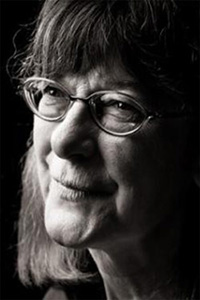
Wright State University
Reception (in lobby) at 5 p.m.
Lecture at 6 p.m.
Dr. Mary Power received a B.A. from Brown University, an M.S. from Boston University’s Marine Program, and a PhD from the University of Washington. Her research interests center on how attributes of species affect food web struc-ture and dynamics, and how strengths of these interactions change under different environmental regimes. She has studied, for example, the interplay of trophic dynamics with hydrologic and productivity regimes in northern Califor-nia rivers, as well as impacts of invading alien species, and linkages between rivers and their watersheds. Much of her work has been conducted at the Angelo Coast Range Reserve, a field station that she directs for the University of California Natural Reserve System. Among her many honors and awards, Dr. Power has been a Guggenheim Fellow, has served as president of numerous research societies and on the Board of Editors of Science magazine, and is an elected fellow of the California Academy of Sciences, the American Academy of Arts and Sciences, and the National Academy of Sciences.
Sponsored by The Environmental Sciences PhD Program, The Department of Biological Sciences, The Department of Earth and Environmental Sciences, The Society of Sigma Xi and the College of Science and Mathematics.
Call 937-775-3273 for more information.
2013
"Diversity and Distribution of Avian Malaria Parasites: A Model System for Pathogen-Host Interactions"
Dr. Robert Ricklefs, University of Missouri-St. Louis
Monday, March 18, 2013
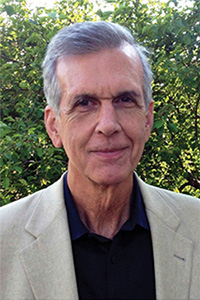
Wright State University
Reception (in lobby) at 5 p.m.
Lecture at 6 p.m.
Dr. Robert Ricklefs is the Curators' Professor of Biology at the University of Missouri, St. Louis. He graduated with a B.S. from Stanford University in 1963 and a Ph.D. from the University of Pennsylvania in 1967. He did postdoctoral research at the Smithsonian Tropical Research Institute before taking a faculty position at the University of Pennsylvania. He is the recipient of numerous awards for his ornithological research and leadership in the field of ecology, including the American Ornithologists' Union 's William Brewster Memorial Award, the Pacific Seabird Group 's Lifetime Achievement Award., the Margaret Morse Nice Medal by the Wilson Ornithological Society, and the Cooper Ornithological Society’s Loye and Alden Miller Research Award. He has made major contributions to island biogeography theory, and has made major conceptual advances in the field of community ecology in general. His popular textbook Ecology was first published in 1973. Among his many other awards and honors, Dr. Ricklefs was inducted into the National Academy of Sciences in 2009.
Sponsored by The Environmental Sciences Ph.D. Program, The Department of Biological Sciences, The Department of Earth and Environmental Sciences, The Society of Sigma Xi, and the College of Science and Mathematics.
Call 937-775-3273 for more information.
2012

Dr. Chris Poulsen, University of Michigan
Tuesday, May 15, 2012
Gandhi Auditorium, White Hall
Wright State University
Reception (in lobby) at 5 p.m.
Lecture at 6 p.m.
Dr. Chris Poulsen delivered the third annual Wayne Carmichael Lecture in Environmental Sciences to a full house on Tuesday May 15. Dr. Poulsen, a climate scientist from the Department of Earth and Environmental Sciences at the University of Michigan, gave a talk entitled “How Climate Works and What it Means for the Future”.
2011
"Science and Policy of Biological Invasions: From Kudzu to Carp"
Dr. David Lodge, University of Notre Dame
Thursday, May 19, 2011

Wright State University
Reception at 5 p.m.
Lecture at 6 p.m.
David M. Lodge is a Professor in the Department of Biological Sciences, Director of the Center for Aquatic Conservation, and Director of the new Environmental Change Initiative at the University of Notre Dame. Lodge is a freshwater ecologist whose research focuses on eco- system services and ecological forecasting to better inform environmental risk analysis, bio- economics, policy, and management. Lodge completed his D.Phil. at Oxford University as a Rhodes Scholar, is an Aldo Leopold Leadership Fellow, and was the first chair of the US national Invasive Species Advisory Committee. Lodge’s research, published in over 150 scientific papers, has been featured in many videos, TV news including NBC Nightly News and Nightline, radio shows including NPR’s All Things Considered, magazine articles including the New Yorker, and newspapers including The New York Times. He has frequently provided testimony on invasive species to US congressional committees.
Lodge Lab
Center for Aquatic Conservation
Sponsored by The Environmental Sciences Ph.D. Program, The Department of Biological Sciences, The Department of Earth and Environmental Sciences, The Society of Sigma Xi, and the College of Science and Mathematics.
Call 937-775-3273 for more information.
2010
"Dirt: The Erosion of Civilizations"
Dr. David Montgomery, University of Washington
Tuesday, May 11, 2010
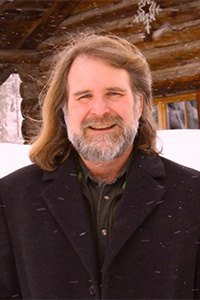
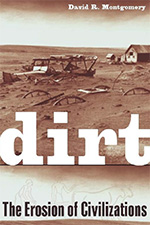
Wright State University
Reception at 5 p.m.
Lecture at 6 p.m.
Macarthur Fellow David R. Montgomery studies geomorphology, the evolution of landscapes. He graduated from Stanford University in 1984 with a B.S. in geology and from U.C. Berkeley in 1991 with a Ph.D. in geomorphology. He is a professor in the Department of Earth & Space Sciences at the University of Washington. His research interests range from the co-evolution of the Pacific salmon and the topography of the Pacific Northwest to the environmental history of Puget Sound rivers, interactions among climate, tec-tonics, and erosion in shaping mountain ranges, and giant glacial floods in eastern Tibet. He is the author of Dirt: The Erosion of Civilizations and King of Fish: The Thousand-Year Run of Salmon.
Sponsored by The Environmental Sciences Ph.D. Program, The Tecumseh Land Trust, The Department of Biological Sciences, The Department of Earth and Environmental Sciences, The Society of Sigma Xi, and the College of Science and Mathematics.
Call 937-775-3273 for more information.
